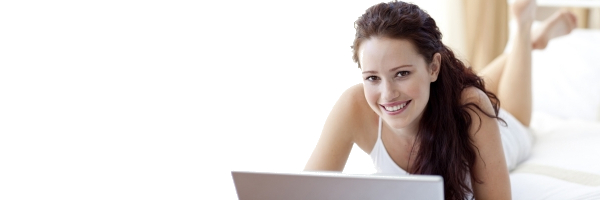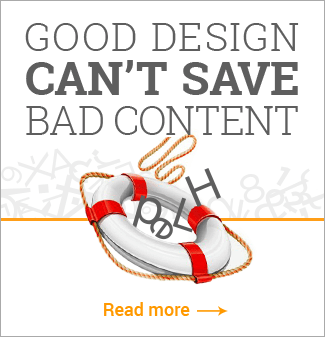
When writing web content, always put the most important information at the start.
This is exactly what journalists do. It’s called the inverted pyramid. You’re letting your readers decide if the page they’re on — or even the paragraph — is relevant to their needs or wants.
Suspense works wonderfully in fiction and some types on nonfiction. But on the Web, you should not delay conclusions or your main point.
If you do, your readers, should they decide to invest more time scanning your web content, will be thinking: where’s this going? What’s the point here? Those questions will dominate their minds, not allowing them to focus on the important points you need to deliver.
When it comes to web writing, give the conclusion first and follow it up with the evidence. You’ll save your visitors grief and help your business.

How you present yourself on your website can make, maim or kill your business. But before you can even consider placing a word on your website, you need to establish a brand strategy.
Good to Great’s best-selling author Jim Collins calls this the Hedgehog concept (based on the philosophy great companies know one big thing). He insists you need to grasp three intersecting elements:
best-selling author Jim Collins calls this the Hedgehog concept (based on the philosophy great companies know one big thing). He insists you need to grasp three intersecting elements:
1. What you can be the best in the world at
2. What drives your economic engine
3. What you are deeply passionate about
Continue reading →

Enthusiasm is wonderful, if it’s sincere. Faking it — on or off the Web — comes across loud and clear.
In decades past, sales teams started off each week with pep meetings to stir up excitement. The overly-inspired salesman then jumped from door to door, entertaining his prospects as he pushed his goods.
Under the influence of artificial enthusiasm, he was a fast talker and wouldn’t take no for an answer. Prospects eventually resented the high-pressure pitches.
Today, those tactics aren’t tolerated for even a second. And that’s about how long it takes for an online visitor to click the back button.
People are sick of spam, and “We’re the best in the business!!!!!” reeks of rubbish. You’re stating: “We’ve got nothing to say, so we’re going to compensate our shortcoming with hype.”
Genuine enthusiasm is powerful. It’s contagious. But if you fake it, you will be called on it. And fast.
Posted on Feb 18 2008 4:07 am by Web Copywriters
tags: Web Content Strategy Writing for the Web
|
category: Writing for the Web |
1 Comment

The Web can be a cold place. Web types dissect a myriad of stats: visits, page views, bounce rates. These are important and valuable tools, but one must not forget a customer is not a cold statistic.
People have feelings and emotions, which will sway them toward your business – or away from it.
Every online visitor brings you his wants. If you take the time to know him and understand his needs, you can provide web content that will engage him, alleviate his concerns and doubts, and entice him to do business with you.
Treating people like stats, on or off the Web, is an attitude that inflicts insult and may not be forgiven. Treat each prospect as a VIP. Show them respect.
Posted on Feb 15 2008 2:03 am by Web Copywriters
tags: Website Conversions Writing for the Web
|
category: Writing for the Web |
1 Comment

Does your web content truly focus on your clients, or is it ‘all about you’?
Webcopyplus recently consulted a couple of IT firms. Business owners who are tech-savvy tend to feel most comfortable explaining the solutions they sell in a rational, linear and feature-centric manner.
IT businesses, or any businesses for that matter, need to take a step back and view their web content from their customers’ perspective.
Continue reading →
Posted on Feb 6 2008 4:05 pm by Web Copywriters
tags: Writing for the Web
|
category: Writing for the Web |
Leave a comment

Using the right words in your web content can make a powerful first and lasting impression.
Making a mark is especially important on the Internet, where your website is up against more than 100 million other eager competitors.
These few fundamentals can help grab your visitors and persuade them to take a desired action.
Posted on Jan 18 2008 10:29 pm by Web Copywriters
tags: Writing for the Web
|
category: Writing for the Web |
Leave a comment

Poorly structured web content is misleading and wastes millions of hours daily. For today’s 1.2 billion Internet users, that translates to frustration. For business, it means missed opportunities.
Is your website optimized for visitors? If your site contains complicated navigation, confusing classifications, self-centric web copy, outdated information and counter-intuitive designs, probably not.
It’s All About the Customer
What you want to say is not important; it’s all about what the customer wants to do. What is he or she striving to attain or achieve? That defines a task. It might be to find a real estate agent, book a hotel room or purchase software.
If the task is completed on your website, your visitor wins — and so do you.

European web designers are churning out poor text legibility, unclear menus and confusing task flows, reveals a recent study by Forrester Research.
Nine top European web design agencies offered two of their best reference sites to the research group for rigorous review. Forrester reported it was surprised at the blunders, which it stated “are all well-researched usability problems, often with known solutions.”
The research group went on to state: “Customer experience experts can fix these problems by simply applying scenario design principles and better standards for text fonts and sizes, and by using web analytics to identify task-flow problem spots.”
Continue reading →

I just finished editing a media advisory for an IT firm, and had to strike out a few lines of hyped-up, unsubstantiated statements followed by exclamation marks.
The U.S.-based company is reputable and there was no intention to mislead. The in-house marketing team simply meant to create excitement within the industry.
The problem is when you overstate, online visitors instantly become wary of your web copy. That doesn’t do you any favours when you consider most people are already suspect about the Internet.
Continue reading →
Posted on Nov 18 2007 10:46 pm by Web Copywriters
tags: Writing for the Web
|
category: Writing for the Web |
2 Comments

What you write is what you are, especially on the Web.
Yet many business owners only relate their online brands to logos and design, discounting the power of the written word.
Your business communicates its brand with every word you use on your website. Through language, we conceive a personality, set a tone and create expectations — for better or worse.
Continue reading →














